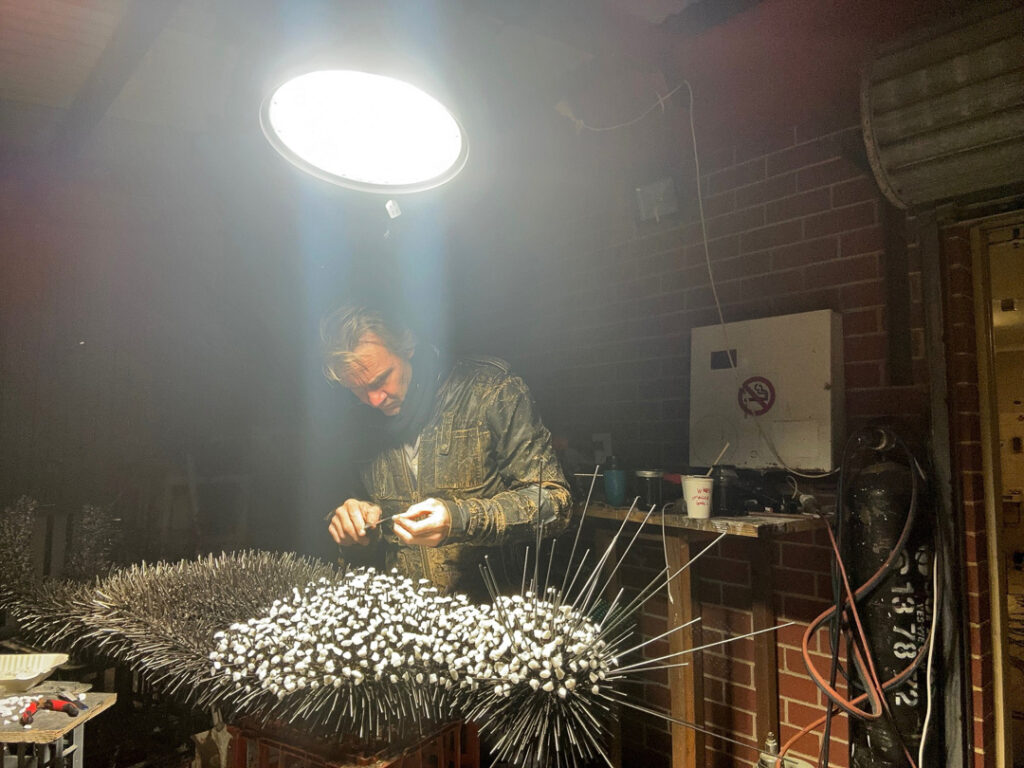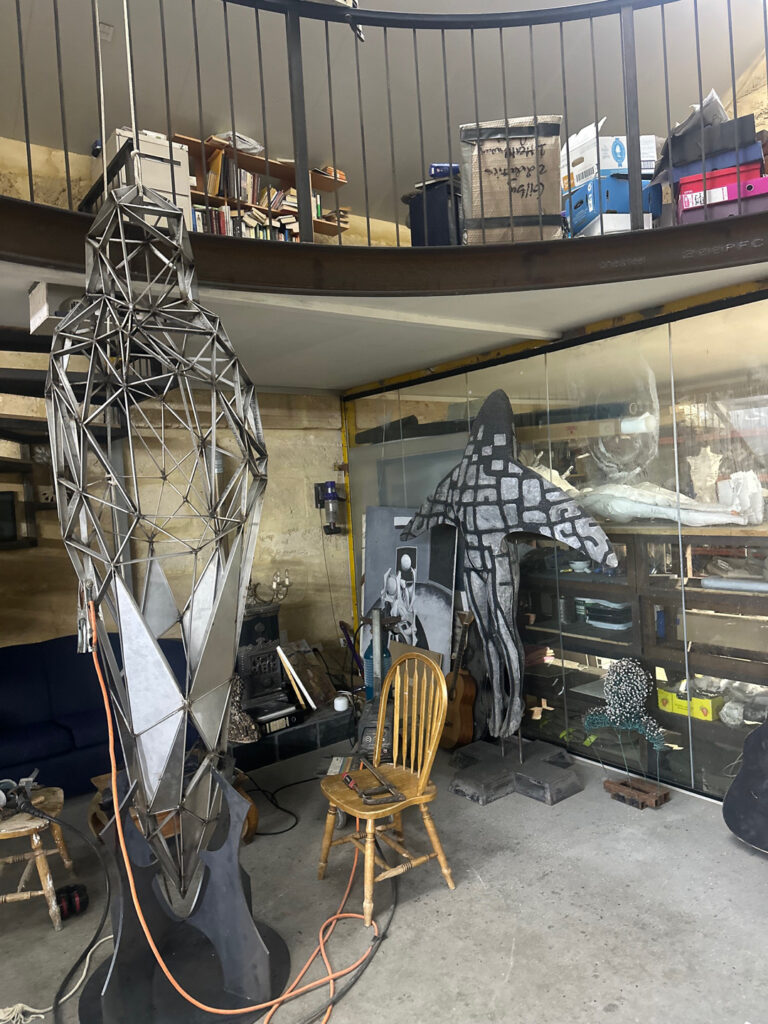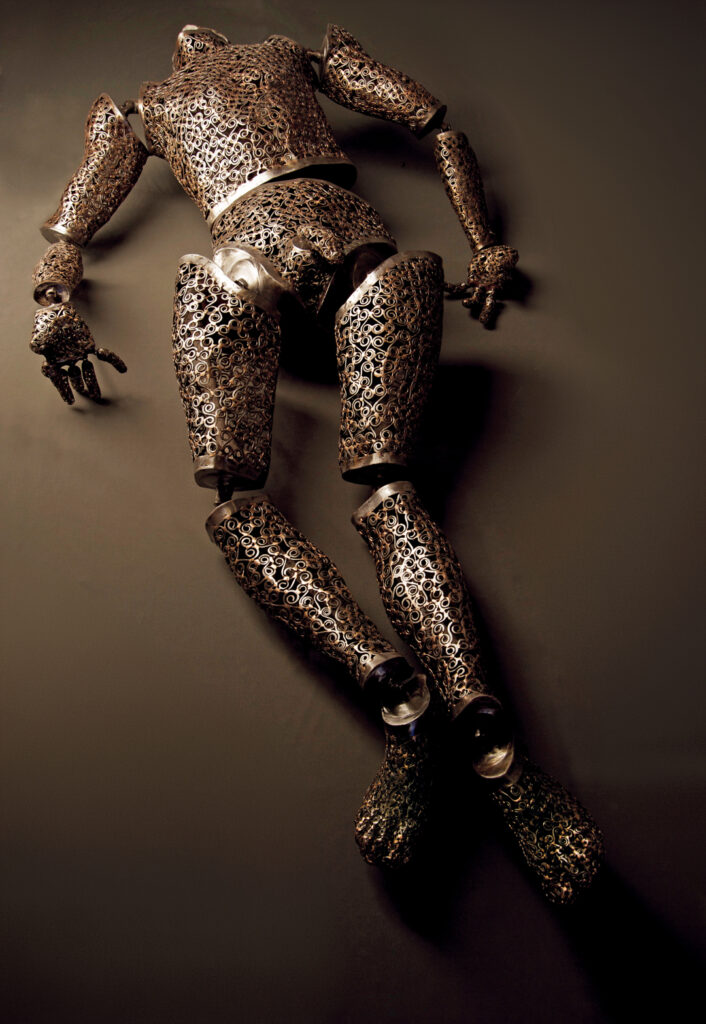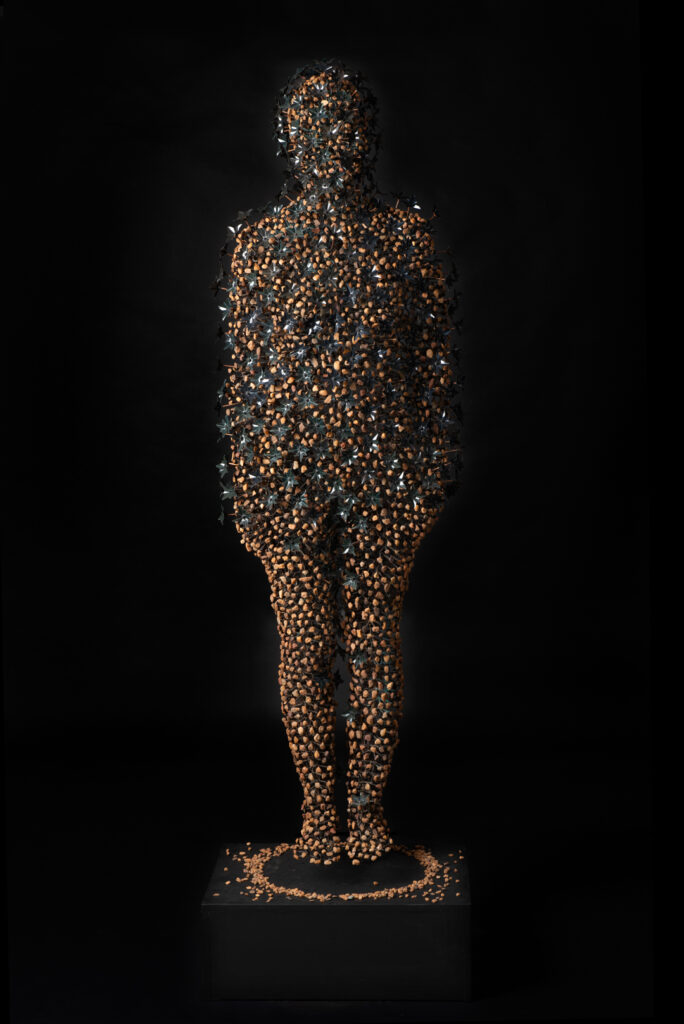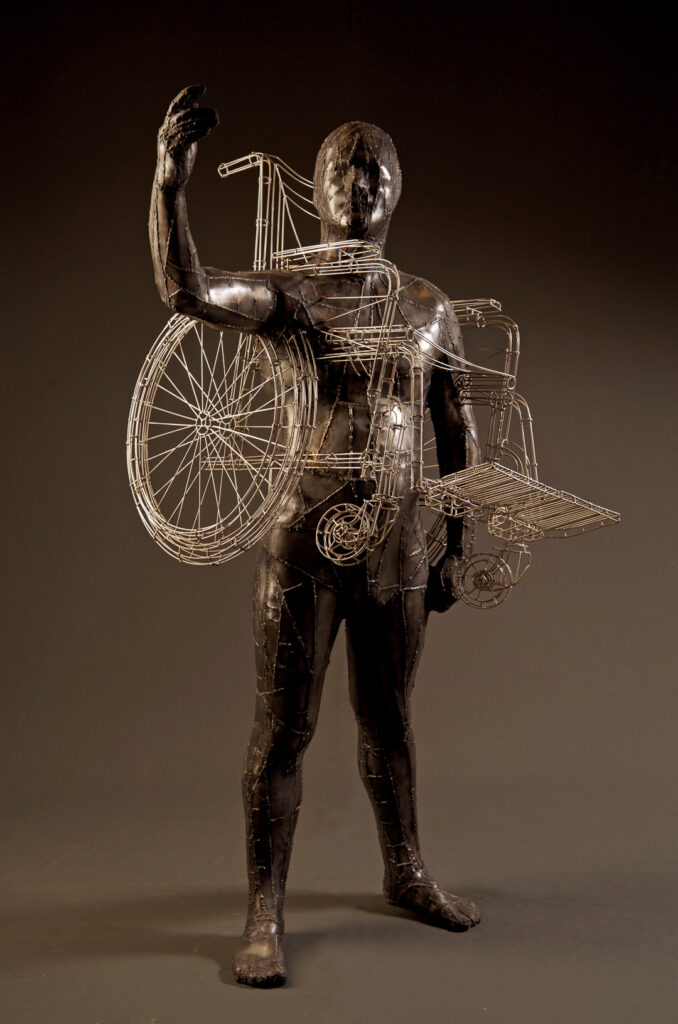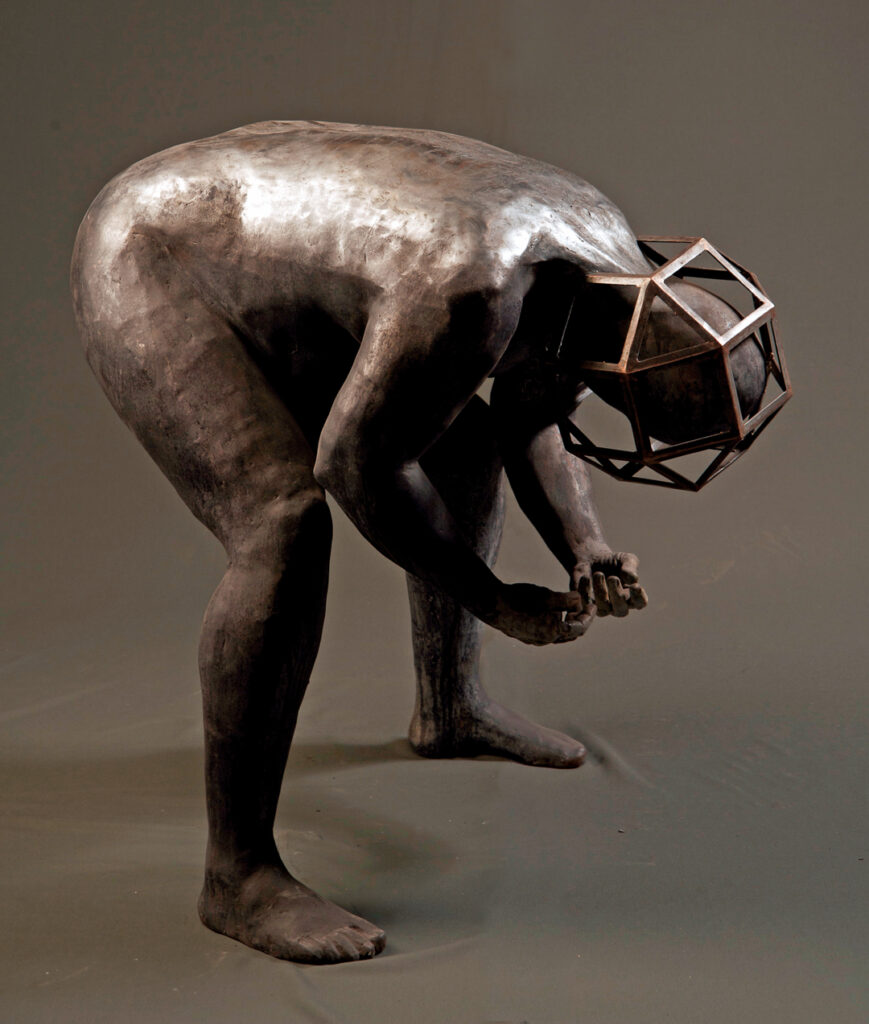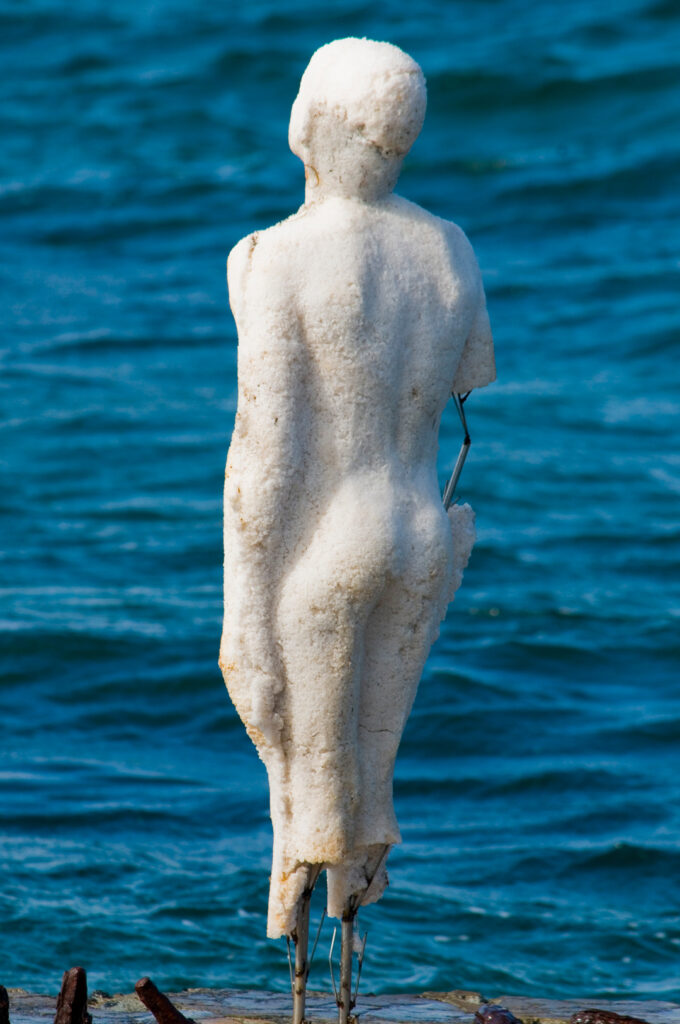Richard King discovers a sculptor whose work deconstructs the individual and so opens us up to the world.
On a bleak industrial state outside Fremantle, Simon Gilby is smiling broadly, waving me up towards the spacious unit that temporarily serves as his artistic studio. His advice was to wrap up warm, which I’ve done, though I notice that Gilby himself is wearing a motorcycle jacket so spectacularly derelict a gust of wind may do for it. I wonder if it’s the one he was wearing in the accident that almost did for him twelve years ago, when he was thrown from his BMW R100 trying to avoid two kids who’d run onto the road. I make a mental note to ask him, though it will have to wait until we’ve finished talking about whatever it is we’re talking about – rather suddenly, and in great depth and detail …
This is the way it tends to go with Gilby. We’ve known each other for less than a year, but already we’re sympatico, given to long and dense conversations about art, creativity and the nature of the self. He reached out to me in 2023 after reading my book on technology and human nature, Here Be Monsters: Is Technology Reducing Our Humanity? (Monash University Publishing), to tell me that I’d given expression to some of the themes explored in his work. Since then we’ve been in regular contact. The plan is to collaborate on a project in the near future, though what form this will take remains undetermined.
Today, Gilby is especially animated, thanks to some positive news he’s received about a public artwork, Kaarl Boyak Naariny (‘fire burning on the rocks’), that will transform Fremantle’s Walyalup Civic Centre. Unusually ambitious for a public commission, and developed in collaboration with Sharyn Egan, a WA-based Noongar artist, the plan is for an under-glass fire vessel at the intersection of church and council land, to be dropped beneath the paving stones and raised for public ceremonies. Around that, arranged in rough ellipse, will be standing stones from the fourteen Noongar regions, as well as symbolic representations of both the Milky Way and the Dark Emu constellation, picked out in up-lights and burnt Jarrah respectively. Sourcing the stones from the Noongar clans is for Gilby and Egan no mere technicality but the central element of the work itself: in giving their consent to the project, and in making a gift of a stone to the City, the clans will become co-creators of it. ‘Despite all the cement paving, convict limestone, glass and asphalt,’ Gilby tells me, with his customary attention to materials, ‘it is firstly their home and in a way more than anyone’s. For the rest of the community, the one I come from, I hope the work will be both welcoming and unsettling, providing a moment to contemplate our own strangeness and an opportunity to recognise what we don’t know … I hope it creates a beginning of wisdom and conciliation in a meaningful way.’
Gilby has other commissions on the boil. At present, his workspace is dominated by a number of botanical-humanoid structures commissioned for the North Metropolitan TAFE located in the Perth suburb of Balga. Referencing the native trees that grow on and around the college campus, these structures will also give expression to the skills and trades developed at the college, either through the materials used to create them, or through their animated parts – a symbiosis of nature and technics that is very much to Gilby’s taste, linked as it is to an overall ethos of ecological sustainability. As Gilby puts it: ‘I wanted to create something that perhaps captured the shift, a shift in intention, from technologies and skills in the service of extraction to those needed for a more sustainable relationship to the world … My hope is that when students encounter these works, which are questioning hybrids of internal human and external nature, it may encourage that kind of thinking around sustainability.’
Such pieces are a large part of Gilby’s work, but they do not form the heart of it. Like many artists working within what Guy Rundle has called ‘the culturestate’ (that mesh of grants and public commissions that serves as an effective patron to creatives of whatever field), Gilby is ambivalent about the world of public art, with its necessary compromises and byzantine bureaucracies. Not that he is at all dismissive of the notion of an art that faces outwards to the world, in the sense of being a necessarily social or reciprocal activity. On the contrary, he is preoccupied with it: it’s a theme we return to again and again in our conversations (in today’s no less so) and serves to bring his major pieces into conversation with each other. Indeed, I think it would be fair to say that Gilby’s most important pieces together constitute an investigation of what it means to ‘have’ a self in a highly individualised society (when we talk, we circle back incessantly to the distinction between selfhood and mere identity, which, in my work, describes the rupture between a society based in face-to-face relations and one given over to technological mediation – between, that’s to say, a grounded sociality and its techno-capitalist simulacrum). Riffing on the old Jonathan Miller joke – ‘I’m not a Jew, just Jewish’ – he asks if we are now ‘selfish’, and whether art, as the place where one human being reaches out to others in unobvious ways, is (or might be) a way to solder the disaggregated self back together, even if only fleetingly. Nor am I being merely picturesque in my choice of a metallurgical metaphor. For Gilby, who works in the hardest metals, it is through the embodied engagement with the world that such reaggregation occurs. For all his philosophical exertions, Gilby is above all a maker – one pushing back in his very practice against a dematerialised notion of the human condition.
Nowhere is this more apparent than in the handful of remarkable pieces created for his exhibition The Syndicate (2011), and in the figures he has produced since then under the rubric of ‘Unselfing’ – sculptures that amount to a sustained interrogation of the desocialised and desacrilised self. Often cast from the bodies of life models, these figures reference civic statuary but are possessed of a desperate vulnerability that puts me in mind of the Garden of the Fugitives – that site of thirteen ‘bodies’ at Pompeii petrified by hot gas from Vesuvius. This ambiguity is caught as well in the tension between the materials used – steel, mostly, but also pewter, resin, stone, cement and tar – and the intricacy of their individual designs. Incorporating exquisite filigree and latticework (sometimes etched with texts or images) and what might be described as a sort of sculptural pointillism – the use of nuts and bolts, for example, to describe the outward form of a figure – the figures have a hollowness that at once belies their physical heft and gives them a sarcophagal quality that is uncanny in its effect on the viewer. (Even if one doesn’t want to, one thinks at times of stock humanoid characters like the Mummy or CP3O, or even Pinhead from the Hellraiser movies.) It is this hollowness that is taken up especially in Gilby’s most recent work, in a way that underlines the tension between solidity and diffuseness. ‘[The Syndicate figures] were definitely a progression through the idea of a solid thing that excludes space,’ Gilby tells me; ‘but these [more recent pieces] are kind of responses against that … They’re the edge of where I’m trying to go.’
- ‘Simon Gilby, Corpus, 2011, brazed filigree, welded steel, uni-joints, skeleton, text, finishes, 240cm (h), other dimensions variable, photo Ashley de Prazer’
- Simon Gilby, Ash, 2011, welded steel rod, nuts, bolts, cast resin, finishes, 178cm (h) by 85 (w), Collection of Ron and Sandra Wise, photo Ashley de Prazer
- Simon Gilby, Unselfing, 2024, metal, river stones, MRI film, 175cm (h) by 55cm (w) by 35cm (d), photo Eva Fernandez
It would be trite to say that Gilby’s figures are expressive of a Cartesian tension between body and soul, or body and consciousness. It would also, I think, be mistaken. For the torment conveyed through these patterned mannequins has more to do with the failure to accept one’s rootedness in the stuff of the world than it does with human embodiment itself. In Messiah, for example, we are confronted with a figure in the style of a Soviet-era statue: an emblem of the totalitarian drive towards power, control and potency. But the figure is also awkwardly encased in the steel skeleton of a modern wheelchair, in a way that comprehensively undermines, or emasculates, its dynamism. In a similar vein, his Architect figure is depicted in a painful crouch, his head in a geometric cage that stands as an abstract counterpoint to the scuffed hands he desperately contemplates. Again, I have a powerful sense that whatever ‘spiritual’ message inheres in these muscular-vulnerable effigies is to be found in their stubbornly human form: these figures are not in flight from their bodies but from the abstracting, individualising tendencies that cause them to forget themselves—their simple solidarity with the stuff of the world. Indeed, to say that a message ‘inheres’ in these works at all seems inappropriately dualistic. It would be more accurate to say that they embody their own message and that whatever that is is inseparable from the artist’s own obsessive engagement with his materials, and the proficiencies he brings to the them.
- Simon Gilby, Messiah, 2011, welded steel and stainless-steel rod, etched drawings and text, finishes, 182cm (h) by 100cm (w), Collection of Dale and Jan Alcock, photo Ashley de Prazer
- Simon Gilby, Architect, 2011, welded and brazed steel, cast pewter, etched drawing and finishes, 105cm (h) by 105cm (w), Collection of Dale and Jan Alcock, photo Ashley de Prazer
I put this, or something like it, to Gilby and he responds with an encomium to the ‘simple act of material investigation’. This is an approach that makes him sceptical of ‘the nuggets of precise presentation’ that are emerging at the intersection of a determinedly conceptual art practice and the development of technologies such as 3D printing. Indeed, I think it would be fair to say that he believes that the act of artistic creation should itself be a multidimensional process in which content, form and practice combine to give effect to that holistic humanness the want of which is anatomised in his statues. If at times those figures seem to be straining to disappear into nature at large, it is this deeper humanity to which they aspire. In Verona and Nuytsia, for example, the human body appears to crave its own subsumption into something larger. The remarkable intervention Entitlement 1, a salt figure is cast from the body of a young boy and bolted onto a derelict gun turret off Bathers Beach in Fremantle (where it was eroded by the ocean waves over a period of 120 days), is similarly hopeful of reintegration. This latter work—a big hit with the locals—is possessed of a solitary transience that, so far from being depressing, brings its own surroundings to life as the site of something grounded and permanent.
- Simon Gilby, Entitlement 1, 2015, salt, 160cm (h), other dimensions variable
- Simon Gilby, Entitlement 1, 2015, salt, 160cm (h), other dimensions variable
I leave Gilby working on his ‘humanoid trees’, one of which will be in steel and glass and contain a functioning ecosystem, or so he tells me, with the air of a man who is beginning to think he may have overpromised. I wish him luck and head for home, with a caffeine headache and the now-familiar sense of having been in the company of someone whose art is materially inseparable from his sense of the kind of creatures we are, and who is as serious and obsessive in the pursuit of his vision as anyone I know or have met. Later, typing up my notes, I curse myself for forgetting to ask about that dilapidated motorcycle jacket, but resolve to include it anyway. What could be more Gilbian, after all, than an artefact at once dense and diffuse, worn and weighed-down and yet threatening at any moment to disappear into nothingness?
About Richard King
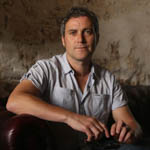 Richard King is an author and critic living in Fremantle, WA. He has written for many newspapers, magazines and websites in Australia and the UK, and writes regularly for Arena Online and Arena Quarterly. His latest book is Here Be Monsters: Is Technology Reducing Our Humanity? (2023, Monash University Publishing). Currently he is writing a book on technology and the eco-crisis, to be published in 2025.
Richard King is an author and critic living in Fremantle, WA. He has written for many newspapers, magazines and websites in Australia and the UK, and writes regularly for Arena Online and Arena Quarterly. His latest book is Here Be Monsters: Is Technology Reducing Our Humanity? (2023, Monash University Publishing). Currently he is writing a book on technology and the eco-crisis, to be published in 2025.

